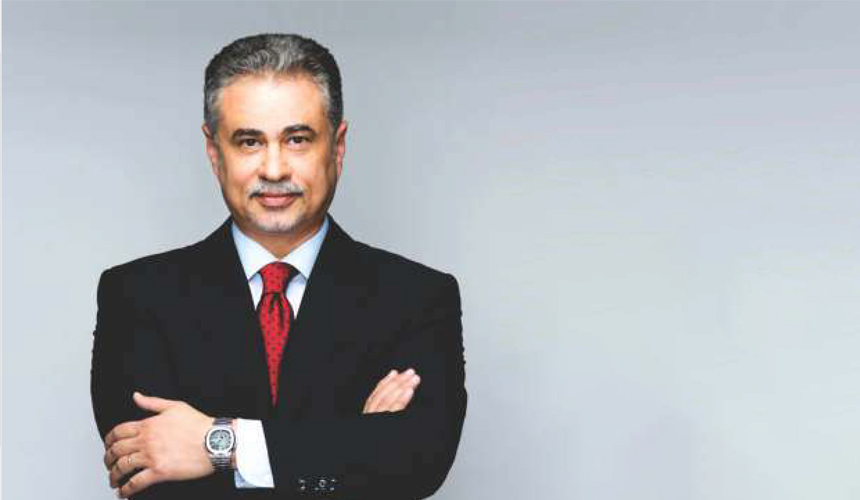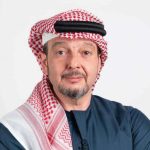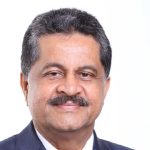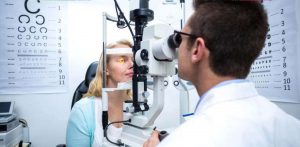 The global ophthalmic devices market size was valued at $5.0 billion in 2021 and is anticipated to expand at a compound annual growth rate (CAGR) of 5.0% from 2022 to 2030. The market growth can be attributed to the rising prevalence of optical disorders such as glaucoma, cataract, diabetic retinopathy, and vitreo retinal disorders, coupled with technological advancements in ophthalmic surgical as well as diagnostic instruments required for these target applications. Improved government initiatives to increase awareness related to visual impairment is further anticipated to widen the base for the market growth (Grand View Research)
The global ophthalmic devices market size was valued at $5.0 billion in 2021 and is anticipated to expand at a compound annual growth rate (CAGR) of 5.0% from 2022 to 2030. The market growth can be attributed to the rising prevalence of optical disorders such as glaucoma, cataract, diabetic retinopathy, and vitreo retinal disorders, coupled with technological advancements in ophthalmic surgical as well as diagnostic instruments required for these target applications. Improved government initiatives to increase awareness related to visual impairment is further anticipated to widen the base for the market growth (Grand View Research)
The most popular eye surgery in the UAE is cataract surgery, which is a procedure to change the transparency of the crystalline lens inside the eye and replace it with an artificial lens. This is popular because it’s commonly related to aging, but can also be caused by other factors like intraocular inflammation or long-term use of corticosteroid eye drops.
The eye care industry in the United Arab Emirates is growing rapidly, with new clinics and hospitals opening up across the country. This growth is driven by the increasing demand for quality eye care services, as well as the availability of skilled manpower and state-of-the-art facilities.
The UAE has some of the best eye care facilities in the world, and is home to some of the leading ophthalmologists and optometrists. These professionals provide a wide range of services, including eye examinations, contact lens fittings, and surgery.
With the growing popularity of Abu Dhabi and Dubai as tourist destinations, the eye care industry in the UAE is expected to continue to grow in the coming years.
 The UAE has a really developed and first-rate eye care industry. In fact, it’s often compared to the services in developed countries like the US and Europe. The sector is always striving to be on the cutting edge of technology. For example, a surge in eye clinics and specialized hospitals in the past 10-15 years. The UAE government provides the rules and regulations for any healthcare provider to succeed and give their best for patient benefits. In the past, many patients used to travel abroad to seek state-of-the-art medical help. But now we see patients coming from all around the world to try and nd a cure for their problems in the UAE.
The UAE has a really developed and first-rate eye care industry. In fact, it’s often compared to the services in developed countries like the US and Europe. The sector is always striving to be on the cutting edge of technology. For example, a surge in eye clinics and specialized hospitals in the past 10-15 years. The UAE government provides the rules and regulations for any healthcare provider to succeed and give their best for patient benefits. In the past, many patients used to travel abroad to seek state-of-the-art medical help. But now we see patients coming from all around the world to try and nd a cure for their problems in the UAE.
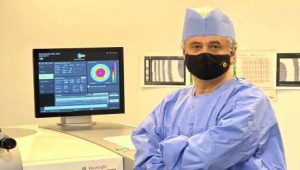 The global ophthalmic devices market size was valued at $5.0 billion in 2021 and is anticipated to expand at a compound annual growth rate (CAGR) of 5.0% from 2022 to 2030. The market growth can be attributed to the rising prevalence of optical disorders such as glaucoma, cataract, diabetic retinopathy, and vitreo retinal disorders, coupled with technological advancements in ophthalmic surgical as well as diagnostic instruments required for these target applications. Improved government initiatives to increase awareness related to visual impairment is further anticipated to widen the base for the market growth (Grand View Research).
The global ophthalmic devices market size was valued at $5.0 billion in 2021 and is anticipated to expand at a compound annual growth rate (CAGR) of 5.0% from 2022 to 2030. The market growth can be attributed to the rising prevalence of optical disorders such as glaucoma, cataract, diabetic retinopathy, and vitreo retinal disorders, coupled with technological advancements in ophthalmic surgical as well as diagnostic instruments required for these target applications. Improved government initiatives to increase awareness related to visual impairment is further anticipated to widen the base for the market growth (Grand View Research).
Dr. Hani Sakla, (Vision Correction Solutions and a world renowned consultant ophthalmologist in Dubai gives Ayesha Rashid of Mediworldme a detailed overview of the UAE eye care industry.
Tell us about your journey in the eye care industry?
I came to the UAE in the 90s. Before that, I was working and living in Spain. I was jealous of the business model they had there for eye surgery at the time. It was becoming a daycare surgery instead of a hospital, and patients were only admitted for a few hours not days like in other countries at that time. So I decided to adapt this business model and bring it to the UAE. I started at Dubai Hospital, which is a government-run facility. We used to admit patients for cataract surgery, for example, and gradually we made it so that they didn’t have to be admitted overnight.
In 2009, I opened my rst surgery center for eye surgery in Jumeirah. This allowed us to do surgeries as daycare without having to stay in the hospital for a few days before and after the surgery. Our patients loved it and we quickly became very popular. 10 years later, I opened my second center on Sheikh Zayed road which included a dry eye spa – something that was new and innovative till this time. As we were first in the Gulf region to launch such an innovation we quickly became popular and started getting VIP patients.
How are these considerations such as stress, self-medication shifting consumer lifestyles, shaping the demand for eye care?
We have a problem with self medication in the UAE because we have an open market and patients can easily buy medication over the counter. This can lead to misuse and improper use of medication, which delays proper management and treatment. Stress is also a big factor in many diseases, and eye problems are no exception.
Stress can cause Central serous chorioretinopathy? That’s a disease where uid leaks under the retina. It’s commonly found in people who are under a lot of stress, don’t get enough sleep, or have a lot of worries. This can lead to sleep apnea and cause vision problems. When we examine people with this condition, we often see leakage under the retina. It can take a long time to treat, so it’s important to be aware of the role that stress can play in our health.
These days, people are working longer hours in front of computers, and this is causing a lot of eye problems such as burning redness, transient blurring of vision, watering eyes, and photosensitivity.
With everyone spending so much time staring at screens, it’s no wonder that eye problems are on the rise. If you spend a lot of time in front of a computer, make sure to take breaks every 20 minutes or so to relieve stress on your eyes. Looking at something in the distance for 20 seconds will help you blink more and relieve any symptoms you might be experiencing.
Which kind of eye care surgery is most popular in the UAE and would that eye surgery still be popular in the future or be replaced on some other eye surgery?

The most popular eye surgery in the UAE is cataract surgery, which is a procedure to restore the transparency of the lens inside the eye and replace it with an artificial lens. This is popular because it’s commonly related to aging, but can also be caused by other factors like intraocular inflammation or long-term use of corticosteroid eye drops. Additionally, trauma to the eye can cause cataracts. So there are many causes for cataracts, making it the most popular surgery in UAE and even worldwide. Other popular surgeries in UAE include refractive surgeries or laser vision correction surgeries like LASIK. This is due to the younger population in UAE as well as the prevalence of myopia (short-sightedness) among newer generations.
How has technological advancements in the ophthalmology field boosted the adoption rate of medical devices globally?
Ophthalmology is a highly competitive eld, and in order to ma int a in our position a s a premi e r prov ide r of ophthalmology services, it is important that we stay ahead of the curve when it comes to new technology and innovation. This not only benets our patients, but also helps to build and maintain their trust in our services. By investing in new cutting edge technology, we are able to provide our patients with the best possible care and treatment available.
How has the regulatory and operating environment for Eye Care changed in the UAE?
In the UAE, the regulatory and operating environment is trying to be on the patients’ side, rather than on the providers’ side (i.e. the doctors). This is of course also helping the doctors by having conversations with the regulatory bodies, healthcare providers and insurance providers.
There is an organized relationship between the doctor, patient and the insurance payer. The UAE also has a healthcare regulation department that monitors customer complaints with transparency and investigates them thoroughly. This is reassuring to patients.
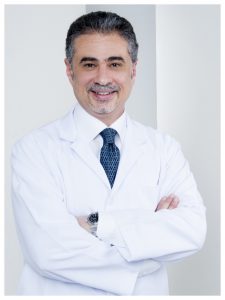 About Dr. Hani Sakla
About Dr. Hani Sakla
Dr. Hani Sakla is a third generation ophthalmologist – his father, Dr. Fouad, graduated in 1956 and his grandfather, Dr. Ragheb, graduated in 1922. The three generations graduated from Kasr Al Ainy School of Medicine in Cairo, the oldest in the Middle East . Medicine and Ophthalmology have always been a vocation and passion in the family, with many cousins and uncles working as doctors in five continents.
Dr. Hani Sakla, a Spanish national, was born in Cairo, Egypt in 1963. In 1997 he successfully obtained the Doctorate Degree from the University of Miguel Hernandez in Alicante with the highest note of Apto Cum Laude.
The pioneer group in Spain that developed and advocated the LASIK procedure in Spain and around the world, under the supervision of Professor Jorge Alio and Dr. Perez Santonja in Alicante Institute of Ophthalmology. He also participated in the first book ever published in the world about LASIK in 1997.
He has many studies published in international peer reviewed journals including the journal o f Ophthalmology from the American Academy of Ophthalmology AAO, the Journal of Cataract and Refractive Surgery from the American Society of Cataract and Refractive surgery ASCRS, the Journal of Refractive Surgery from the International Society of Refractive Surgery ISRS, and many others.
Since 1989 he dedicated his practice to cataract and intraocular implant surgeries, corneal surgeries, keratoplasties, all refractive procedures with excimer laser like LASIK , Epilasik , Ultralasik , Femtosecond Lasik, besides implant refractive surgeries like Phakic Lenses ICL, or clear refractive lens exchange. He also specialized in glaucoma diseases and medical retina.
He soon moved to Dubai to work as a consultant eye surgeon, where he introduced the phacoemulsification technique and the sutureless cataract surgeries with foldable lenses and made it a popular technique among his peers. Dr. Hani Sakla was elected as the chairman of the scientific committee in the Emirates Medical Association till 2010. In the course of his service, he organizes many internationa l ophthalmology conferences in Dubai.
Hi grandfather was a doctor and his father and now his son Yousef Sakla will be the 4th generation of ophthalmologists in the family. He is married to Nancy Sakla.







